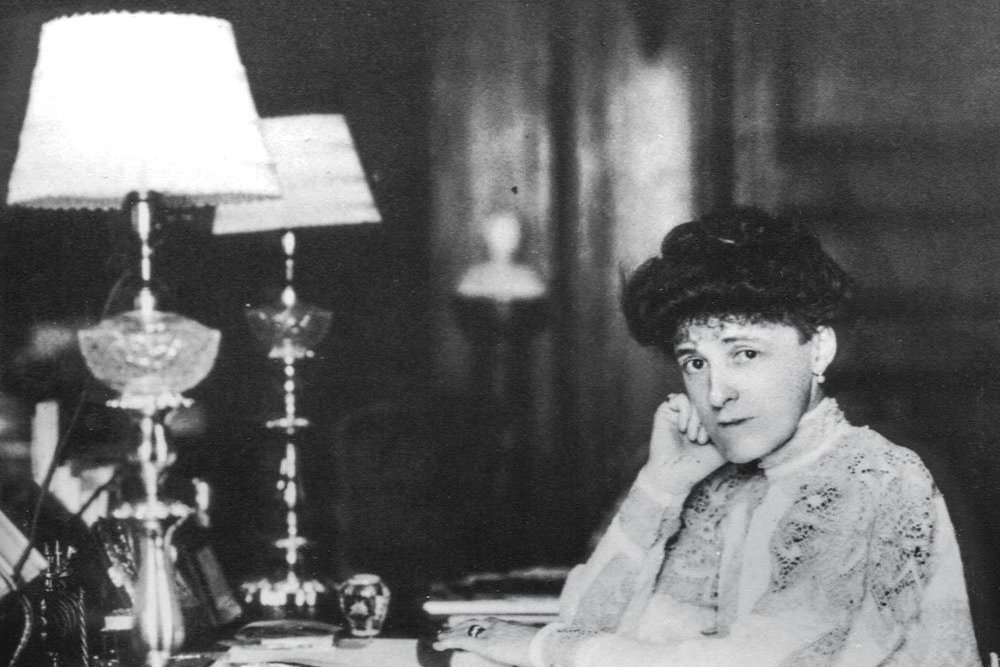Edith Wharton née Jones was born into the family that is believed to have inspired the phrase “keeping up with the Joneses.” Her first memory was of a male cousin lifting her veil and kissing her, and at age nine she nearly died of typhoid while vacationing at a spa in the Black Forest; she recalled having been saved by “the physician of the Czar of Russia.” She wrote her first novel at eleven; it began, “‘Oh, how do you do, Mrs. Brown?’ said Mrs. Tompkins. ‘If only I had known you were going to call I should have tidied up the drawing-room.’” She submitted the manuscript to her mother. “Never shall I forget the sudden drop of my creative frenzy,” she later wrote, “when she returned it with the icy comment: ‘Drawing-rooms are always tidy.’”
Her parents’ opinion of her writing had apparently improved enough in the subsequent years for them to privately print her first poetry collection, Verses, when she was sixteen. She received her coming-out party when she was seventeen, one year earlier than the average debutante’s emergence into society, and that same year (1879) she published a poem about a twelve-year-old boy’s solitary confinement and suicide in a Philadelphia reformatory. She soon found her literary production to be “checked.”
Six years later Jones married Teddy Wharton, in whose bedtime company she suffered asthma attacks, and six years after that his father killed himself. The doctors assured the Whartons that his condition was not heritable.
Wharton cowrote her first professionally published book, The Decoration of Houses (1897), with Ogden Codman, Jr., a renowned architect. “Nothing has done more to vulgarize interior decoration than the general use of gas and of electricity in the living-rooms of modern houses,” the manual avers.
Her husband was suffering from toothaches and agitation. “Teddy Wharton seems to be losing his mind,” Codman observed five years later, “which makes it very hard for his wife.” They filed for divorce in 1913, after Teddy had had his teeth removed and both had had adulterous affairs. “Everyone is unconsciously tyrannized over by the wants of others,” according to The Decoration of Houses. “The unsatisfactory relations of some people with their rooms are often to be explained in this way.”
Wharton was by this point a famed writer. Her first short-story collection, The Greater Inclination, had been published in 1899 and “broke the chains which had held me so long in a kind of torpor.” Her first story for Harper’s Magazine was published two years later, and The House of Mirth followed in 1905.
She immersed herself in charity work in France during the war, and was disgusted by American nonintervention. On February 8, 1918, she explained Americans to four hundred intellectuals in an address at the Société des Conférences. “It is a masterpiece,” wrote her friend Bernard Berenson, who had removed the “h” from his first name to make it seem less German. “So clear & crisp & brief, and yet containing it all.”
“The world is getting to be such a lonely place,” Wharton told a friend toward the end of the war. She wrote The Age of Innocence between September 1919 and March 1920 because she wanted a “momentary escape.”
“Was She Justified in Seeking A Divorce?” asked a lurid advertisement for the novel. “Why was this American girl forced to leave her brutal Polish husband?”
The novel received the Pulitzer Prize, and before the decade’s end she would receive gold medals from the National Institute of Arts and Letters and the American Academy of Arts and Letters; she was elected to the Royal Society of Literature but resigned after weighing the four-guinea cost against the negligible benefit. A young and uncredited F. Scott Fitzgerald wrote the title cards for a silent film adaptation of her novel The Glimpses of the Moon (1922), but most went unused.
Wharton died on August 11, 1937.














































































































































































